The External Defibrillators Market is estimated to be valued at USD 4.9 billion in 2025 and is projected to reach USD 13.2 billion by 2035, registering a compound annual growth rate (CAGR) of 10.4% over the forecast period.
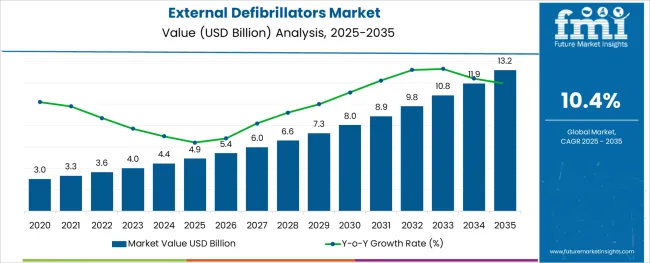
The alginic acid market is undergoing consistent growth, propelled by rising demand from food processing, pharmaceutical formulations, and cosmetic applications. A growing focus on natural and sustainable ingredients in manufacturing processes has positioned alginic acid as a preferred biopolymer across industries.
The market is further supported by its diverse functional benefits, including water retention, gelling, and stabilizing properties, which make it indispensable in high-performance formulations. Increased regulatory acceptance of alginates as safe additives and the push towards cleaner labeling in food and personal care products have reinforced their adoption.
Ongoing innovation in extraction technologies and the utilization of algae as a renewable resource are paving the way for cost-effective production and expanded applications, ensuring sustained market expansion in the coming years.
The market is segmented by Application Type and region. By Application Type, the market is divided into Manual External Defibrillators, Automated External Defibrillators, and Wearable Cardioverter Defibrillators. Regionally, the market is classified into North America, Latin America, Western Europe, Eastern Europe, Balkan & Baltic Countries, Russia & Belarus, Central Asia, East Asia, South Asia & Pacific, and the Middle East & Africa.
The market is segmented by Application Type and region. By Application Type, the market is divided into Manual External Defibrillators, Automated External Defibrillators, and Wearable Cardioverter Defibrillators. Regionally, the market is classified into North America, Latin America, Western Europe, Eastern Europe, Balkan & Baltic Countries, Russia & Belarus, Central Asia, East Asia, South Asia & Pacific, and the Middle East & Africa.
When segmented by salts, sodium alginate is expected to command 27.5% of the market revenue in 2025, marking it as the leading subsegment in this category. This leadership has been driven by its superior solubility, ease of incorporation into formulations, and versatility in a wide range of applications.
Its ability to form stable gels and maintain viscosity under varying conditions has made it highly sought after in both food and pharmaceutical sectors. Manufacturers have prioritized sodium alginate due to its consistent performance, cost-effectiveness, and regulatory acceptance, which have collectively strengthened its position.
The segment’s prominence has also been enhanced by its adaptability to evolving consumer preferences for plant-derived and sustainable ingredients, reinforcing its market share.
As per the External Defibrillator research by Future Market Insights - a market research and competitive intelligence provider, historically, from 2020 to 2024, the market value of external defibrillators increased at around 8.6% CAGR, wherein, countries such as the USA, China, and Japan held a significant share in the global market.
The constant surge in urbanization has also aggravated healthcare needs across several countries. Owing to this, the demand for an external defibrillator is projected to grow at a CAGR of 10.4% over the coming 10 years.
In the elderly population and individuals suffering from chronic conditions such as high blood pressure, obesity, and heart disorders, atrial fibrillation, which is characterized by an irregular and most often rapid heart rate, can raise the risk of stroke, heart failure, and other heart-related complications. According to a study released in NCBI 2024, atrial fibrillation is perhaps the most common cardiac arrhythmia, with a global prevalence of 3 billion people diagnosed in 2020. Furthermore, according to the WHO report for 2024, heart disease and stroke account for 85% of all cardiovascular fatalities.
Defibrillators are devices that provide an electric shock to restore a regular heartbeat. They are used to treat or prevent arrhythmias. Furthermore, the launch of numerous new defibrillators with easier insertion technology, smaller size, and fewer or no leads placed in the heart is expected to propel the external defibrillators market growth. Biotronik, for example, introduced the Acticor gadget series of innovative ICDs and cardiac resynchronization therapy defibrillators (CRT-Ds) in 2020. The hybrid ICD Acticor devices provide dual-chamber diagnostics without the use of an atrial lead.
The rising prevalence of hypertension among the global population, as well as an increase in cardiovascular illnesses such as arrhythmias and bradycardias, will boost the external defibrillators market. In addition to an aging population, people who are more likely to have heart-related disorders are expected to boost the external defibrillators market.
Furthermore, rising healthcare expenditures, improved healthcare infrastructure, technical improvements, and an increase in disposable income in developing nations are all factors that are expected to enhance the market. Furthermore, the increasing push of several governments to install external defibrillators in public locations other than hospitals in order to prevent sudden cardiac death is a major driver driving the growth of the external defibrillators market.
Rapid technical advancements, as well as favorable government regulation, are expected to propel the External Defibrillators market over the forecast period.
AEDs (automated external defibrillators) are life-saving devices that assist in cardiac rhythm correction. The rising prevalence of cardiac disorders, the expanding elderly population, and technical developments in the industry, supported by increased investment by market participants, are the key factors propelling the market.
During the projected period, North America is expected to dominate the external defibrillators market. In 2024, North America had the highest revenue share, accounting for more than 35%. This dominance can be attributed to the rising prevalence of cardiovascular disorders, improved healthcare infrastructure, and the presence of significant external defibrillator market participants in the region. Furthermore, the risks of developing cardiovascular disease are skyrocketing in the United States. The presence of key manufacturers in the region, such as Stryker, ZOLL, and Phillips, among others, would also boost the market for external defibrillators.
In 2024, Boston Scientific, for example, reported that it had distributed around 33,000 CRT-Ds devices worldwide, including Ring true, Autogen, Dynagen, Incepta, and Cognis. There were 16,500 registered devices in the United States alone, indicating a significant adoption rate.
The market for external defibrillator treatments in North America is also rising due to the region's growing geriatric population and high consumer awareness. Furthermore, the presence of market competitors and increasing demands for modern medical systems in the area contribute to the region's leading market position.
Due to improvements in research infrastructure, an increase in the geriatric population, and a high prevalence of cardiovascular illnesses, the European market is projected to swell. Furthermore, Asia Pacific held a significant share and is expected to be the fastest-growing regional market, owing to an increased incidence of heart attacks, and the presence of a large patient pool suffering from cardiovascular diseases; especially in emerging economies such as Hong Kong and Singapore.
The improvement of technology in these countries has created a profitable opportunity for the worldwide defibrillator market to flourish. During the projection period, the market in Latin America and the Middle East, and Africa is expected to rise at a slower pace.
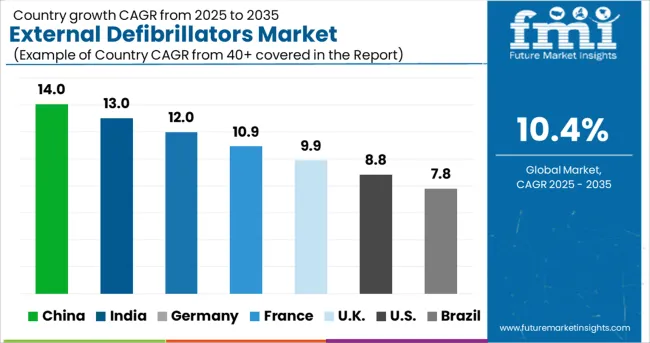
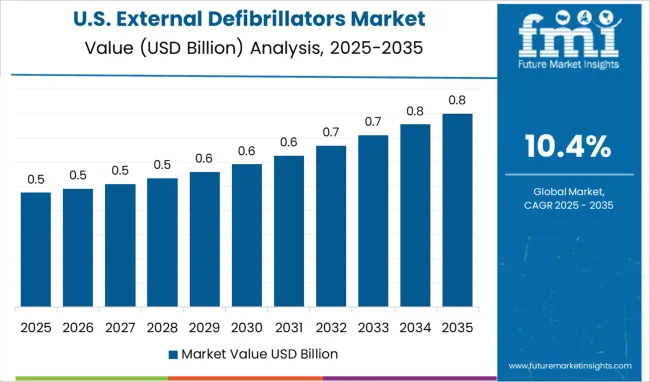
With an over 11.5% projected growth rate, external defibrillators market revenue is expected to grow at the fastest pace in the USA, from 2025 to 2035. The market in the USA is predicted to grow due to the presence of a well-developed healthcare infrastructure, which is also rising due to the region's growing geriatric population and high consumer awareness. Furthermore, the presence of established market competitors and increasing demand for modern medical systems in the area contribute to the region's leading market position.
The external defibrillators market in the United Kingdom is expected to reach a valuation of 13.2 Million by 2035, at a CAGR of 10%. The market growth from 2020 to 2024 was observed at 8.5%.
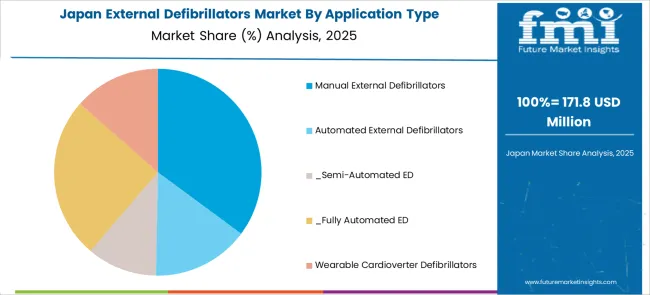
The Japanese external defibrillator market is expected to witness an absolute dollar growth of USD 4.9 Million, growing at a CAGR of 10.3% from 2025 to 2035. The market is projected to reach a valuation of USD 416.5 Million by 2035.
The external defibrillators market in South Korea is projected to account for an absolute dollar opportunity of USD 99 Million. By 2035, it will reach a valuation of USD 156.5 Million growing at a CAGR of 10.5%.
During the projection period, manual external defibrillators are anticipated to lead the market. The rising frequency of cardiovascular disorders and the introduction of technologically improved defibrillators are responsible for the considerable share of manual external defibrillators. Besides, manual external defibrillators are also cost-effective, which is the key factor for their high share.
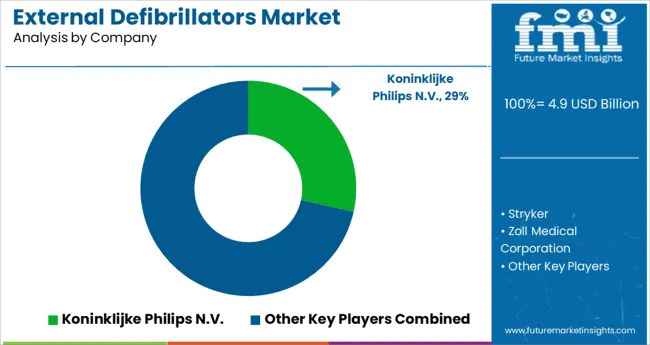
Some of the key companies operating in the external defibrillators market include Medtronic, Stryker Corporation, Koninklijke Philips N.V., Asahi Kasei Corporation, Boston Scientific Corporation, Abbott, Nihon Kohden, MicroPort, BIOTRONIK, CU Medical Systems, METsis Medikal, Mediana Co. Ltd., and Mindray Medical International.
Some of the recent developments by key external defibrillator providers are as follows:
Similarly, the Future Market Insights team has been keeping track of recent advancements in the field of external defibrillators, which are detailed in the complete research.
The global external defibrillators market is estimated to be valued at USD 4.9 billion in 2025.
It is projected to reach USD 13.2 billion by 2035.
The market is expected to grow at a 10.4% CAGR between 2025 and 2035.
The key product types are manual external defibrillators, automated external defibrillators, _semi-automated ed, _fully automated ed and wearable cardioverter defibrillators.
segment is expected to dominate with a 0.0% industry share in 2025.






Our Research Products

The "Full Research Suite" delivers actionable market intel, deep dives on markets or technologies, so clients act faster, cut risk, and unlock growth.

The Leaderboard benchmarks and ranks top vendors, classifying them as Established Leaders, Leading Challengers, or Disruptors & Challengers.

Locates where complements amplify value and substitutes erode it, forecasting net impact by horizon

We deliver granular, decision-grade intel: market sizing, 5-year forecasts, pricing, adoption, usage, revenue, and operational KPIs—plus competitor tracking, regulation, and value chains—across 60 countries broadly.

Spot the shifts before they hit your P&L. We track inflection points, adoption curves, pricing moves, and ecosystem plays to show where demand is heading, why it is changing, and what to do next across high-growth markets and disruptive tech

Real-time reads of user behavior. We track shifting priorities, perceptions of today’s and next-gen services, and provider experience, then pace how fast tech moves from trial to adoption, blending buyer, consumer, and channel inputs with social signals (#WhySwitch, #UX).

Partner with our analyst team to build a custom report designed around your business priorities. From analysing market trends to assessing competitors or crafting bespoke datasets, we tailor insights to your needs.
Supplier Intelligence
Discovery & Profiling
Capacity & Footprint
Performance & Risk
Compliance & Governance
Commercial Readiness
Who Supplies Whom
Scorecards & Shortlists
Playbooks & Docs
Category Intelligence
Definition & Scope
Demand & Use Cases
Cost Drivers
Market Structure
Supply Chain Map
Trade & Policy
Operating Norms
Deliverables
Buyer Intelligence
Account Basics
Spend & Scope
Procurement Model
Vendor Requirements
Terms & Policies
Entry Strategy
Pain Points & Triggers
Outputs
Pricing Analysis
Benchmarks
Trends
Should-Cost
Indexation
Landed Cost
Commercial Terms
Deliverables
Brand Analysis
Positioning & Value Prop
Share & Presence
Customer Evidence
Go-to-Market
Digital & Reputation
Compliance & Trust
KPIs & Gaps
Outputs
Full Research Suite comprises of:
Market outlook & trends analysis
Interviews & case studies
Strategic recommendations
Vendor profiles & capabilities analysis
5-year forecasts
8 regions and 60+ country-level data splits
Market segment data splits
12 months of continuous data updates
DELIVERED AS:
PDF EXCEL ONLINE
External Anthelmintic for Dogs Market Size and Share Forecast Outlook 2025 to 2035
External Storage Market Size and Share Forecast Outlook 2025 to 2035
External Fixator Market Size and Share Forecast Outlook 2025 to 2035
External Anti-infective Preparations Market Size and Share Forecast Outlook 2025 to 2035
External Blinds Market Size and Share Forecast Outlook 2025 to 2035
External Pacemakers Market Size and Share Forecast Outlook 2025 to 2035
External Gear Pump Market Size, Growth, and Forecast 2025 to 2035
External Combustion Engine Market Growth & Demand 2025 to 2035
Animal External Fixation Market Size and Share Forecast Outlook 2025 to 2035
Automated External Defibrillator Market Analysis – Size, Share, and Forecast 2025 to 2035

Thank you!
You will receive an email from our Business Development Manager. Please be sure to check your SPAM/JUNK folder too.
Chat With
MaRIA